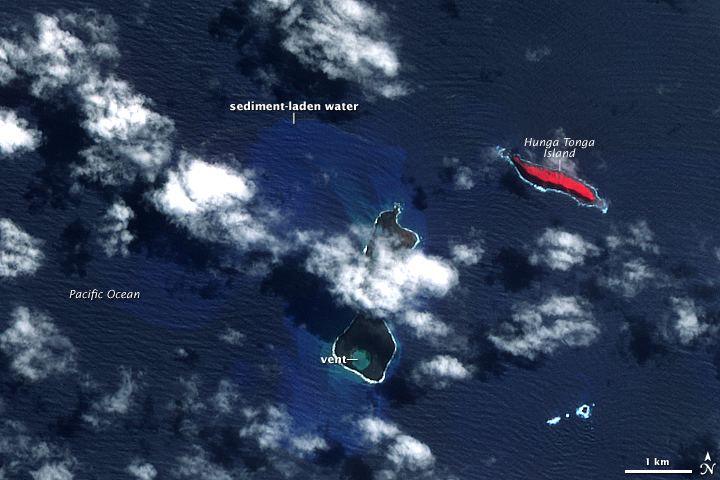 | ||
The 2009 Tonga undersea volcanic eruption began on March 16, 2009, near the island of Hunga Tonga, approximately 11 kilometres (6.8 mi) from the Tongan capital of Tongatapu. The volcano is in a highly active volcanic region that represents a portion of the Pacific Ring of Fire. It is estimated that there are up to 36 undersea volcanoes clustered together in the area.
Contents
Eruption history
The initial March 16–17 eruption sent ash and smoke up to 20 kilometres (12 mi) into the atmosphere and an initial inspection reported that the volcano has breached the ocean surface. Authorities suggested at that time that the eruption did not yet pose any threat to the capital's population, and an inspection team was sent out to evaluate the volcano.
Between March 18–20, a number of Surtseyan eruptions sent ash plumes as high as 4 kilometres (2.5 mi) to 5.2 kilometres (3.2 mi) into the atmosphere, with prevailing winds pushing the ash cloud about 480 kilometres (300 mi) east-northeast of the eruption site and widespread and significant haze reported at Vavaʻu 255 kilometres (158 mi) away. Steam plumes on March 20 were measured at 1.8 kilometres (1.1 mi) above sea level. But on March 21, an eruption sent steam and ash just 0.8 kilometres (0.50 mi) into the sky. On March 21, Tonga's chief geologist Kelepi Mafi reported lava and ash from two vents, one on the uninhabited island Hunga Haʻapai and another about 100 m (330 ft) offshore, had filled the gap between the two vents, creating new land surface that measured hundreds of square metres. The eruption devastated Hunga Haʻapai, covering it in black ash and stripping it of vegetation and fauna.
Disruptions
Two Air New Zealand airline flights into Tonga were delayed due to safety concerns caused by the volcanic ash, but flight schedules returned to normal shortly thereafter.
Tongan officials also expressed concern that the eruption could significantly harm the country's fishing industry.
2009 Tonga earthquake
Four days after the start of the eruption a strong earthquake measuring 7.6 on the Richter scale also struck the region. Ken Hudnut, a geophysicist for the United States Geological Survey, stated that "The association with the volcanic activity seems to be an interesting added dimension to this. It's not clear at this point that there is a direct association, but it seems suggestive at this point.". Keleti Mafi, the Tongan government's chief seismologist, also suggested that the earthquake was likely to have a direct impact on the volcanic eruption, stating that the "strength of the earthquake could crack the volcano's (undersea) vent and allow more magma to be ejected".
